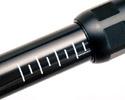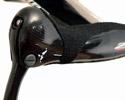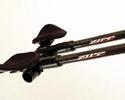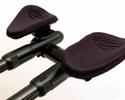
Recently on Cyclingnews.com |
On Test: Zipp Vuka Aero, March 23, 2007
Speedy TT kit for the fortunate few

|
Zipp is most famous for its aerodynamic wheels, having been ridden to victory by Team CSC's World Time Trial Champion Fabian Cancellara and a countless array of other high-profile talent. Zipp now applies its aerodynamics know-how to TT handlebars, and Cyclingnews "time trial specialist" Ben Atkins climbs aboard and sets off against the clock.
Zipp has a long-standing history with cheating the wind when it comes to bicycles, having developed its first disc wheel way back in 1988. The company entered the road handlebar market in 2005 with the ultralight SL model, but the Vuka system is Zipp's first foray into cockpit components designed specifically for time trials and triathlons. Naturally, aerodynamic performance was a key target for the Vuka, but Zipp also wanted to retain enough structural rigidity to withstand the stresses of a rider climbing out of the saddle. After borrowing a bit of technology from a fairly unconventional source (more on this soon), Zipp finally felt that it was ready to offer something unique, and worthy of its prestigious brand name.
What's a 'Vuka', anyway?
Depending on which African language you choose, 'Vuka' means 'rising spirit', 'wake up', or 'wing'. In Zipp-ese, the Vuka Aero is a fully integrated carbon fibre time trial bar system that features wind tunnel tested aerodynamics, integrated carbon brake levers and an innovative biaxial compression sleeve system for securing and adjusting the extensions.

|
The base bar is 42 cm wide and is positioned so as to roughly mimic the location of standard brake hoods on a conventional drop bar set up. Since there is no room for conventional bar tape, the grip areas are covered in a replaceable friction tape to provide a sure perch. The arm rests are covered in a plush anti-bacterial Lycra and are fully adjustable for width, height, and fore-aft.
Zipp offers not just one, but three different styles of extensions for the Vuka: the included 'chicane' set that puts your hands roughly level with your elbows; a fully straight set which puts your hands in a low position; and the traditional ski bend which allows you to have your hands slightly raised.
The manner in which these extensions are attached is one of the details that sets the Vuka Aero apart. Zipp utilizes threaded collets (analogous to what you'd find on a Bridgeport or similar lathe, or even your common cordless drill) that provide a 360° purchase on the extensions for a secure grip. Cleverly, the slight offset built into the collets also allows for 2.5° of angular adjustment (both horizontally and vertically) without the need for any additional clamps or hardware.
Setting up the Vuka Aero
For the most part, installation of the Vuka Aero is reasonably straightforward. The clamp diameter of the Vuka Aero is set at 26.0mm in order to accommodate non-oversized stems (which would presumably present a marginally smaller frontal area), but Zipp also includes adapter shims to fit 31.8mm stems as well.

|
The one major exception to the Vuka's straightforward installation involves the routing the cables. Zipp opted for fully internal routing for a cleaner look and better aero performance. This doesn't create much of a headache with the derailleur lines (which cleverly feed out the back of the hollow collet bolts), but running the brake lines through the base bar can be a bit, er, 'tricky', to put it diplomatically. Thankfully, though, Zipp pre-installs the lines from the factory but users should likely budget additional time (and patience) with subsequent fittings.
I tend to like my arms pretty flat so after a bit of experimentation I settled for the 'chicane' extensions. They come with plenty of length and will require trimming for most people; I cut off around 4cm to replicate my usual position. Getting the extensions at the right angle - and both at the same angle - proved fairly fiddly, but no more so that other bar systems I've used in the past. The collets needed more tightening than I would have expected to stop them from moving under stress, but once everything was correctly positioned and sufficiently tightened (using the tightening tool provided) they felt very secure.
Ride like the wind
Cornering with my hands on the outer handgrips feels very stable, despite the very "low at the front" position. The wisely-placed grip location means that the steering is as predictable as you would normally expect and you're ready to lay down the power as you straighten out of the corner.
The bars really come into their own once you get them on to a flat straight bit of road, and it becomes plainly obvious exactly what it is that Zipp does well: make things that go really fast! While a time trial position will rarely be called comfortable, the armrests are some of the plushest I've ever used and produced none of the pain in my arms that I have suffered through with other bars. It's obviously partly (or mostly?) psychological, but the bars do really feel fast.

|
Once in the tuck position there's nothing to get in the way of the air that passes - except my own non-aerodynamic shape. With the cables neatly routed internally and the minimal size of the brake levers there is very little frontal area to speak of, filling you with the confidence that everything possible is being done to make sure your energy is efficiently propelling you forwards, and as little as possible is needed to fight the forces trying to slow you down.
Had the outer bars been set any narrower - as I have seen with some other systems - climbing out of the saddle would become less stable. I was forced to do this on a couple of the steeper parts of a climb in the middle of an early season race, and Zipp seems to have met its rigidity goals as I found that the carbon wings to be as solid and stiff as anything I've ever tried to bend before.
The Vuka Aero's small brake levers don't look like they're up to much, but due to their well-engineered pivot system they still pull an appropriate amount of cable and actually work really well. If anything, the amount of cable pulled is on the longer end of the scale as I was able to set my brake calipers wide enough to allow 23mm tyres to pass through without the need for a quick release lever, but the brakes were still very strong.
Conclusion

|
If you're looking to win the Tour de France prologue, or to simply shave a few precious seconds off your personal best on the local 10k, then slicing through the air as efficiently as possible is going to be pretty high on your list of priorities and Zipps' new TT bar seems to do this very well.
The Vuka Aero certainly isn't the lightest option on the market, but they're nowhere near the heaviest either. Due to their very wide bladed outer bars it's difficult to see where weight could be saved without making them more flexible, and the rigidity of the system is definitely one of its strong points.
Unfortunately, along with the Zipp performance comes the Zipp price, and there's no getting around the fact that these are easily the most expensive bars I've ever come across. Also, potential buyers should keep in mind that only the 'chicane' extensions are included; those that would prefer the straight or 'ski tip' versions will have to factor that into the budget. However, this is not necessarily a reason to condemn them. If you've got the money and you like spending it on high-end components - and let's face it, at this price, these things are going to be pretty exclusive, too - then you'll likely still want a pair of these.
Weight: 828g (1.90lbs) - depending on style and length of extension
used (claimed weight 860g)
Price: US$1199.95 (including 'chicane' extensions); US$130 (optional straight
or 'ski tip' extensions)
Pros: Slippery aerodynamics, wide range of adjustability, multiple extension
options, extremely rigid, and sexy!
Cons: Prohibitively expensive for all but the most well-heeled, not as
light as some, brake cables difficult to replace
Cyclingnews rating: ![]()
Photography
For a thumbnail gallery of these images, click here
Images by James Huang/Cyclingnews.com
- The Zipp Vuka Aero time trial bar system with 'chicane' extensions (Zipp 145 carbon stem not included).
- The view you'll get... if you buy a pair of these (try and keep your eyes on the road!).
- The view the air will get if it tries to get in your way - very little frontal area at all!
- The view from behind if your bike had eyes.
- The Vuka Aero is a work of art no matter which way you look at it. Brake cables are routed via the undersides of the outer wings.
- The outer grip complete with carbon brake lever is positioned to mimic the place where your brake hoods would be on a road bike.
- Offset collets allow you to angle the extensions 2.5° in any direction.
- The collets are tightened from the rear with the special tool provided.
- It's worth spending some time setting the bars' angles or you could end up with them pointing in different directions!
- If you get the offset collets in the right position (i.e. the same position!) then this shouldn't happen.
- Gear cables can be neatly routed through these holes in the extensions...
Images by Ben Atkins/Cyclingnews.com
Images by James Huang/Cyclingnews.com
- Brake cables are also neatly routed and emerge underneath the outer wings.
- Velcro covered arm rests have three rows of holes which allow a good range of adjustment - but if that's not enough, a riser kit and a wing extension kit are available.
- The third extension shape. The 'ski tip' shape allows you to position your hands above your wrists.
- Extensions are marked with centimetre graduations to make trimming easier.
- The Integrated Aero Collet Tool necessary for tightening the collets and securing the extensions.
- Spacers can be used to allow an oversized stem to be used with the Vuka Aero, or standard sized bars with the Vuka Clip.
- The Zipp Vuka Clip: a clip on system for those who want to turn their road bike into a TT machine (pictured with 'straight' extensions).
- The Vuka Clip is tightened by turning the hexagonal compression sleeves.
- Cables are routed through the Vuka Clip to emerge underneath the bullet shaped body, just in front of the handlebar clamp.
- The Vuka Clip shares the same arm rests as the Vuka Aero and the antibacterial pads are replaceable.



